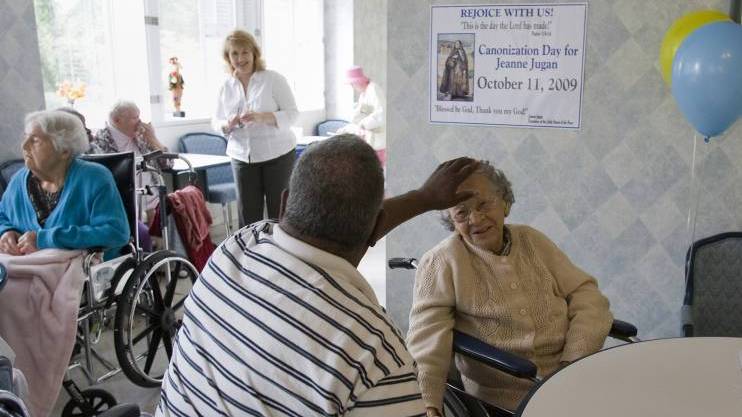

Deacon-structing End of Life | Part 5
Deacon Pedro
Wednesday, July 9, 2014

- Passive Euthanasia: Some will claim that this is disconnecting someone from medical life-support equipment without which they cannot live. This is NOT euthanasia. Disconnecting someone from an artificial life support system is not euthanasia, passive or otherwise. It is called withholding extraordinary care. Disconnecting someone from a respirator without which their lungs (or heart) would not naturally function is not killing them. They are already dead without the machine. This is different than ordinary care, like a feeding tube. In the case of Terri Schiavo, the courts considered that she was receiving extraordinary care, even though she was breathing on her own and her heart was beating on its own. The "extraordinary care" in Terri Schiavo's case was a feeding tube. But feeding someone is not giving them extraordinary care – it’s feeding them. It’s no different than feeding a baby who can’t feed herself. Terri Schiavo didn’t die because they removed a medical life-support system without which she could not live. She died because she was starved to death. Tube or no tube, no one was even allowed to wet her lips with a towel. There’s no dignity, freedom or choice in that. NOTE: It is permissible to have someone on life support (extraordinary care) if there is hope of their recovery. It is permissible to withdraw extraordinary care if there is no hope of recovery. The term "passive euthanasia" is no longer used by those opposed to assisted dying.
- Self-Deliverance is suicide. It’s taking your own life.
- Assisted Suicide is Physician Assisted Suicide. A doctor prescribes drugs and then you take them yourself. He doesn’t assist you in taking them, he assists you by prescribing them. But you have to be able to take them yourself.
- Active Euthanasia: This is the only kind of Euthanasia there is (as opposed to passive euthanasia, which is not euthanasia). This is when the doctor (or someone else) injects the lethal drugs, because you can’t do it yourself. The current law in Canada calls this murder under the Criminal Code. Euthanasia can be voluntary (you asked the doctor to do it), or involuntary. Take note: 2400 or so cases of euthanasia and assisted suicide are reported each year in Holland. But in 1991, the Dutch Government conducted a study that found that there were actually closer to 12,000 assisted suicides that year. Of these, the patient did not request or consent to being killed in close to 6,000 cases. One of the doctors explained that it would have been “rude” to discuss the matter with the patients, as they all “knew that their conditions were incurable.” This is what could easily begin happening now in Quebec. (I wrote that in 2014. Medically Assisted Dying is now legal in Quebec and in all of Canada.)
- Medically Assisted Dying (MAD)/Medical Aid In Dying (MAID): Are terms that include both Physician Assisted Suicide and Euthanasia, as in both cases, the medical system is helping the person hasted their death.
 Every week, Deacon Pedro takes a particular topic apart, not so much to explore or explain the subject to its fullness, but rather to provide insights that will deepen our understanding of the subject. And don’t worry, at the end of the day he always puts the pieces back together. There are no limits to deaconstructing: Write to him and ask any questions about the faith or Church teaching: pedro@saltandlighttv.org
Every week, Deacon Pedro takes a particular topic apart, not so much to explore or explain the subject to its fullness, but rather to provide insights that will deepen our understanding of the subject. And don’t worry, at the end of the day he always puts the pieces back together. There are no limits to deaconstructing: Write to him and ask any questions about the faith or Church teaching: pedro@saltandlighttv.orgRelated Articles:
Category: Deacon-structing, Featured, Life and Family
Tag: assisted suicide, euthanasia
Pope Francis’ Prayer Intention for April 2025
Thursday, April 3, 2025
 Pope Francis
Pope Francis
We join the Holy Father in praying that the use of the new technologies will not replace human relationships, will respect the dignity of the person, and will help us face the crises of our times.
Pope Francis’ Prayer Intention for March 2025
Thursday, March 6, 2025
 Pope Francis
Pope Francis
We join the Holy Father in praying that broken families might discover the cure for their wounds through forgiveness, rediscovering each other's gifts, even in their differences.
Visit local pilgrimage sites this Jubilee Year
Thursday, January 30, 2025
 Maria Montemayor
Maria Montemayor
For the Jubilee of Hope, there are designated local pilgrimage sites in every country, and Canada is no exception. How is a local pilgrimage site determined? The local bishop can designate any parish, shrine, or basilica in his territory as a Jubilee Year pilgrimage site.
Creating Catholic streetwear
Thursday, January 9, 2025
 Maria Montemayor
Maria Montemayor
Fashion and clothing designed to draw people closer to God can inspire and even sanctify others. Nate Nagello, the CEO and owner of the Toronto-based Sanctified Collective, hopes the clothing he creates can provide opportunities for conversation, engagement, and evangelization.
When do you pray the Rosary?
Wednesday, December 4, 2024
 Maria Montemayor
Maria Montemayor
The Rosary is powerful: many graces can be bestowed upon those who pray it, and it can also offer special protection. Reciting the Rosary aloud in church and praying for the pope’s intentions can grant the supplicant a plenary indulgence.










